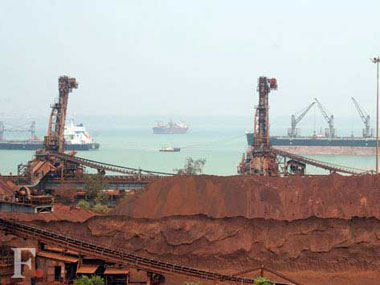Rs. 10,000 Crores Goa Mining Scam Haunts Digambar Kamat
 |
| Locals argue with bouncers employed by a mining company in Goa. The locals are unhappy with a mine in their area |
 |
| Army of Bouncers to scare the villagers |
Bouncers posted by Goan Miners to scare the Villagers !!
Earlier this month, Firstpost published Kamat’s role in winking at illegal mining activities in Goa. He not only allowed it to happen, but also supported it by facilitating environmental clearances for these mines with help from 2G jailbird Andimuthu Raja.
Having held on to the mines portfolio for all of 12 years, Kamat told Firstpost recently that he had asked Jairam Ramesh, when he was Minister of Environment and Forests (MoEF), that no Goa mine should get environment clearance after January 2010.
However, the fact is Kamat was instrumental in getting clearances for 136 Goa mines during Raja’s stint as Union Minister of Environment. That was before he became Communications Minister and got arrested in the 2G scam.
“I myself wrote to Jairam Ramesh. I was the only one to stop environmental clearances to Goa mines from January 2010 onwards till the Union government came up with a new mining policy,” he told Firstpost. Mines need environmental clearances (ECs) every 20 years.
All of Goa’s working and non-working mines came up for environmental clearances between 2005 and 2007, when Raja was the Environment Minister. Before Raja moved out of the ministry in May 2007, he had cleared 136 mines. Ninety of these are operational currently.
The state government’s complicity in Raja’s clearances is evident because an Expert Appraisal Committee visited several mines that were given ECs for mining. The committee says that the ground reports submitted for EC permissions did not match the field reports. The National Environment Appellate Authority constitutes the Expert Appraisal Committee and orders them to visit sites where, among other things, there is public opposition to mining.
In 2010, there was massive public outrage against the Pirna iron ore mine of Sesa Goa (owned by Vedanta). The Environment Ministry had given an EC despite public resistance. Vedanta had asked for an EC for Pirna saying there were no wildlife sanctuaries, national parks, heritage sites, or biosphere reserves within 10 km of the lease.
But when the Expert Appraisal Committee visited the area it found that the river Chapora flowed near the mine on the north. River Chapora is subjected to tidal influence. The committee also found a discrepancy with respect to the mine lease boundaries in the maps. There was a forest nearby, and elephant herds occasionally visited forests in this area.
Many ground reports, also known as Environment Impact Assessment (EIA) reports, were apparently rigged at the local level and presented as ‘normal’ for environmental clearances.
EIA reports fall into two categories. Category A requires clearances from MoEF and Category B from the state government. These EIA reports assess the ecological, forest, river and wildlife conditions at proposed locations and then recommend them for EC permissions.
Interestingly, records from Kamat’s own mines office reveal that 21 of the 90 operational mines did not have ‘wildlife clearance’ and 19 of the existing mines did not have ‘forest clearance’. These clearances are necessary for obtaining ECs. The Rivona mines in Sanguem, South Goa, are actually located on forest land.
In Goa, there are thus some mines with the EC stamp and others with clearances from the state government.
Two recent instances indicate the scale of ‘illegal’ mining and dubious environmental clearances under the Kamat regime.
Tribals in village Caurem met the Chief Minister in February, 2011, bringing to his notice the illegal mining that was happening in their backyards. Kamat promised to stop the mining with immediate effect. This, however, didn’t happen. A month later, the tribals sat on a dharna inside the office of the mines director at Panaji. On 1 March, they sat till 10.30 pm in the night, till the director gave written orders for closure of the illegal mines.
Another instance is the mines owned by Zhatiye at Bicholli. The mines have silted the city’s only river beyond doubt. Several representations have been sent to the CM. He even appointed a committee to look into the matter and the committee squarely blamed the mine owners for the river mess. It was within Kamat’s power to cancel the mines, but he didn’t.
Not only this. Several mining sites now post bouncers—the kind normally seen at pubs or dancing bars in Mumbai—to scare villagers who dare to protest. These well-built bouncers are brought from places like Mumbai, Pune and cities in Karnataka.
The ad hoc system of EC clearances has kept Kamat in business. Whether it is Calangute, Anjuna or Colva beach, if you travel 15 km from any beach you will hit the trail of a mine in Goa. There is a mine for every two km stretch in Goa’s hinterland. “The bloody trail of mining begins at the mine-pits gouged out of Goan earth and follows the ore-laden trucks and barges to the ships at Mormugao port,” says Claude Alvares of the Goa Foundation.
Former Chief Minister and now opposition leader Manohar Parrikar says: “Iron ore production in Goa was about 39-40 million tonnes during 2010-2011. But the iron ore export figure is 45 million tonnes. Where did the additional 5 million tonnes of iron ore come from? I can only give leads. I am not an investigative agency. Let the CBI probe Kamat.”
Meanwhile, the Public Accounts Committee of the Goa assembly is seized of the matter and is enquiring into all the allegations. (courtesy: Raman Kirpal, Andrew Pereira & Firstpost)
Also Read the following news stroies:



No comments:
Post a Comment